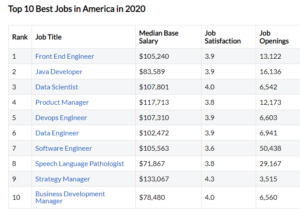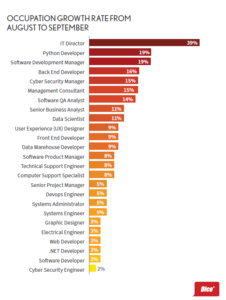
Why Data Science Is Still a Top Job

(pathdoc/Shutterstock)
This year, for the first time since 2016, data scientist is not the number one job in America, according to Glassdoor’s annual ranking. While the shine may be wearing off the unicorn a bit, data science is still a great field to go into, expert tells us, with abundant opportunities, competitive pay, and a job satisfaction that is tough to beat.
With an average salary of $111,200 and an average job satisfaction of 4.25 out of 5, data scientist was at the top of the heap four years running in Glassdoor’s annual list of the top 50 jobs in the United States.
But when Glassdoor released its list at the beginning of 2020, data scientist dropped to third place, behind frontend engineer and Java developer, numbers one and two, respectively. The job satisfaction and salary of those two positions were below that of data scientist, but they had many more job openings, which ultimately tipped the scales.
“While data scientist remains a thriving role, we’re seeing high demand for front end engineers with over 13,000 open roles, nearly double the number of data scientist open jobs,” Glassdoor wrote in January. “In addition to numerous open jobs, front end engineers report competitive salaries and high job satisfaction.”
After growing quickly from 1,700 job postings in 2016 to 4,500 in 2018, growth in data scientist job postings were flat from 2019 to 2020 at around 6,500, according to Glassdoor. A similar trend was on display at Dice, with data scientist falling two positions to 43rd place. The top jobs, according to Dice, didn’t change at all: software developer, project manager, network engineer, systems engineer, and senior software developer retained the one through five spots, respectively.
Clearly, data science is still a niche field in the massive global IT market, which Gartner says will drive $3.9 trillion in spending in 2020 (a number that includes $1.3 trillion telecom spending). In this topsy-turvy year of COVID-19, companies have shifted to a more defensive posture. For companies that were focused on surviving the pandemic, data science dropped in priority.
But it’s not all doom and gloom. As the recovery from the economic lockdown gained steam this summer, Dice detected a sizable increase in data science jobs from August to September alone. In its latest report, Dice noted:
“Back end developer (16%), data scientist (11%) and software product manager (8%) were high-growth occupations from August to September, suggesting yet again that companies are beginning to reorient their focus toward longer-term and larger projects that were perhaps put on hold during Q1 and Q2.”
The growth in demand for Python developers also suggest that “companies may be angling toward resuming business as usual, with a renewed focus on the data analytics and software building that is so crucial to overall business strategies,” Dice continued. “These were fast-growing professions before COVID-19 temporarily disrupted operations.”
While that uptick could prove to be fleeting thanks to resumed COVID-19 lockdowns this fall, tech jobs overall have proven to be resilient during the pandemic, which is now in its ninth month.
“We are seeing a continued demand for technologists even amidst the pandemic,” Art Zeile, the CEO of Dice parent company DHI, stated in a press release last week, “and we expect that, with growing confidence, the trend toward stabilization will continue as organizations digitize and adapt to longer-term remote work flexibility.”
In the long term, it would probably be unwise to bet against data science as career move, especially when you widen the field to include related positions like research engineers and machine learning engineers. The U.S. Bureau of Labor Statistics sees strong, albeit tempered, growth for data science jobs skills in its prediction that the data science field will grow about 28% through 2026.
No matter how you cut it, data science is still a lucrative field with plenty of opportunity, which is why universities continue to add data science programs to their curriculums. According to DataSciencePrograms.org, there are more than 830 separate data science programs being offered from about 500 universities around the world. A Masters of Data Science is the most popular degree offered, it says, while about 135 schools offer data science programs online.
According to Peter Bailis, CEO of Sisu and co-principal investigator of the Stanford DAWN project, the job prospects for would-be data scientists are strong.
“While universities have upleveled and expanded the reach of their data science curricula, the demand for data scientists has also risen,” Bailis says. “I see a huge demand for data scientists and analytics across the board – both at the tech giants and in the broader private sector.”
As technology improves, companies have been able to increase the sophistication of their data operations. Increasingly, that means inserting artificial intelligence (AI) capabilities into the business processes of regular companies (i.e. non-tech giants). And that means demand for data scientists and related positions (research scientists and machine learning engineer) will also go up.
“With better tools for usable machine learning and analytics, the barrier for data science is lower than ever,” Bailis tells Datanami. “Especially with the consolidation of data in standardized formats (e.g., via tools like Fivetran), the time to value for data science investments is lower than ever. The latest platforms for AutoML and augmented analytics bring us much closer to a world where everyone’s an analyst than ever before.”
While the tools are getting better, data scientists looking to accel in the marketplace will still need to have a solid understanding of the basics, including data modeling, relational databases, and basic statistics, Bailis says. Those are critical skills that are likely to survive any future shifts in data science job functions.
And while there will always be new and nifty machine learning techniques, data scientists will usually find better results by focusing their efforts on leveraging the data they already have on hand, Bailis points out.
In the long run, Bailis does see the job of data scientists evolving as the technology changes. As rote tasks that suck up so much time – like data collection, data labeling, model selection, and model interpretation — are automated and the barrier to entry is lowered, the field of data science will flourish, he says.
“AI is letting people focus more and more on what people are best at: understanding the bigger picture from the data, and making creative strategic decisions,” Bailis says. No matter what happens to the data scientist job description, that trend will continue.
Related Items:
Skills Are Critical in Data Science Job Hunt
How COVID-19 Is Impacting the Market for Data Jobs




























